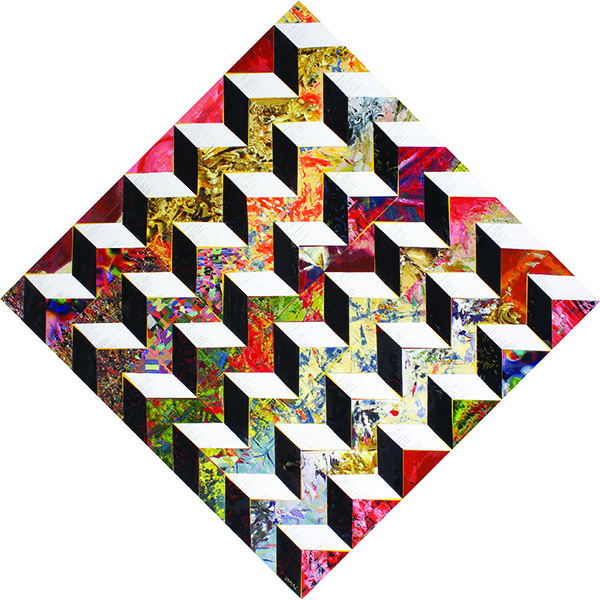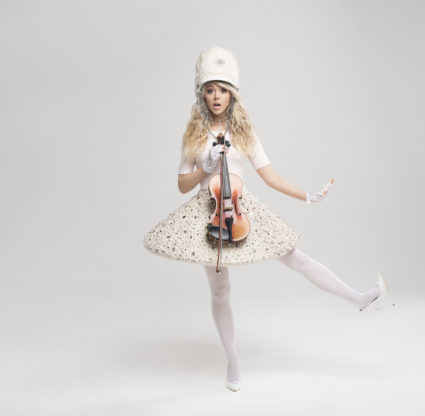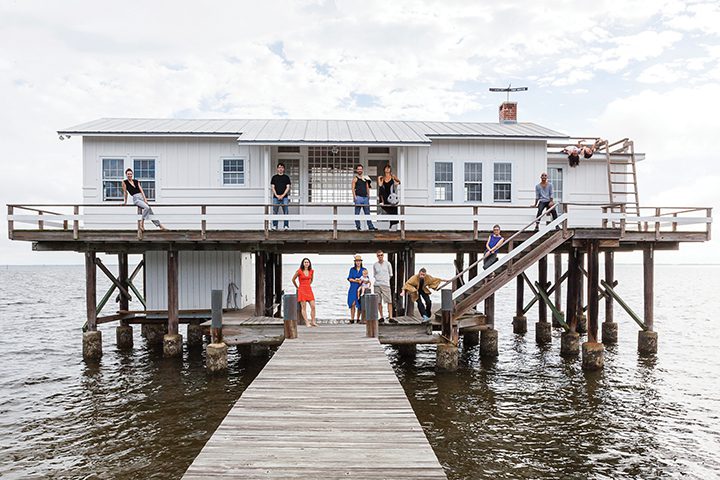He’s taking the back roads these days, Joe McAleer says.
An artist who lives in Bonita Springs, McAleer is going through a big change in his work right now. After several years of painting and making mixed-media works in a hard-edged, geometric style, he’s turning out pieces now in softer, less rigid forms. His old and new styles were on view side-by-side last fall at Samaniego Art in North Naples. McAleer’s older work brings to mind Op Art of the 1960s. His precise and mathematical “Optic Diamond” paintings deploy cubic, two-dimensional shapes to create the illusion of three dimensions. The repetitive forms—dubbed “jump squares” by the artist set up a visual tension, seeming to emerge and recede in space even though the viewer knows they are flat.
In contrast, McAleer’s new paintings have an organic quality. The two small acrylics shown at Samaniego avoid harsh contrasts and complex geometry in favor of meandering shapes. His new color palette has a tropical flavor, tending toward citrus, turquoise and tangerine hues. The canvases feel investigatory, inquisitive rather than completely resolved.
“I don’t know where it’s leading,” McAleer says of his fresh direction. He compares his art-making process to a road trip from Florida to Los Angeles. “I’m on the back roads, trying to go west, not on the superhighway. Along the way, you make mistakes, wrong turns. You break down for a week or so. Then you see a shape, a color, you get an idea. You get back in your car and drive some more. Eventually, you get where you want to go.”
It’s rare for an artist to teach for 40 years and achieve gallery representation later in life, which is what happened for McAleer. He taught painting and drawing at a high school in Moorestown, N.J., doing his own work on the side, until he retired in 2006. In 2007, he was given a one-man show at the prestigious Locks Gallery in Philadelphia. Eventually, he was signed by the nearby Bridgette Mayer Gallery.
He’s well aware of the economic pressures that come with the gallery business. Artists often feel that they have to maintain a signature style sought by collectors and curators. “If you’re not involved with a gallery, you’re your own boss. If you’re involved with a gallery, you get directives from the gallerist. It’s a delicate path trying to maintain the integrity of your vision and what your gallerist feels is sellable,” McAleer says.
Still, he can’t help but wander the back roads. “I want to explore whether I can create a surface that I find engaging, that has movement, structure and interest. I don’t make a lot of political statements in my work. I can’t paint work that I don’t find appealing and interesting. I have to do something that engages me, and when it engages me, it engages me totally,” he says. “I only paint to please myself.”
Style Matters
What is style in art, anyway? Why is the hand of an individual artist often immediately recognizable in a given work? What happens when a mature artist transforms his or her style? It’s common for artists to go through an exploratory phase at the beginning of their careers. They hash over stylistic options inherited from their teachers or artists they love and begin to develop a personal vision. Many then settle into a comfortable groove, their “mature” style. The acquisition and subsequent alternation of an artist’s style is a complex and interesting issue, one that is at the heart of the question of why artists do what they do.
“Style is what is left over when you eliminate content,” says Anne-Marie Boucher, an associate professor of art history at Florida Gulf Coast University. “It’s what exists beyond content. It’s what makes a work of art different and unique. It’s the sum of all the expressive choices and gestures that the artist makes.” She adds that over the millennia since our ancestors began scrawling images of animals on cave walls, artists have exerted conscious control over the look of their work and demonstrated an awareness of the power of their visual language. Sometimes style is affected by market forces or shaped by workshop practices.
“To me, the most profound example of an artist changing his style, and not for shallow reasons, is Rembrandt,” Boucher says. “Rembrandt starts out being very tied into the style of Northern Baroque art. He’s almost indistinguishable from his second teacher, Pieter Lastman. His painting style is dynamic and dramatic, but also solid and detailed.” In the early years of his career, Rembrandt loved exotic details and rich costumes. There was a lot of fantasy and role-playing in his art.
“Then his wife dies. And his style changes overnight. He doesn’t care about the things he used to care about. A lot of things change about his style. He becomes less flashy, more introspective. He becomes more psychological and less tied to the market. His approach to representation is vastly simplified. He’s less interested in creating three-dimensional space. His surfaces are less elaborately worked. It’s very telling. Rembrandt’s style becomes more about Rembrandt. His painterly style becomes his brand.”
Among more recent artists, Picasso is known as the ultimate shapeshifter. He moved from one style to another over the course of his long career—from his early prowess as an accomplished draftsman during his Symbolist, Blue and Rose periods to the ground-breaking development of Cubism at the beginning of the 20th century. He went on to explore Neoclassicism, Surrealism and Expressionism, often working in more than one style at any given time.
Philip Guston (1913-1980) experienced a scathing response when he underwent a major stylistic transformation in the late 1960s. A contemporary of Jackson Pollock and a first-generation Abstract Expressionist, Guston made a name for himself in the art world of the 1950s and ’60s as a painter of gestural, blocky abstractions.
In 1967, he moved to Woodstock, N.Y., and began painting recognizable motifs, such as shoes, cigarettes, light bulbs and Ku Klux Klansmen, rendered in a deliberately crude, cartoonish style. When he exhibited his new work in 1970, the critics stamped their feet, loudly, in print. New York Times art critic Hilton Kramer blasted Guston in a review titled, “A Mandarin Pretending to be a Stumblebum.”
For the record, the stumblebum came out on top. Today, Guston’s later paintings are among the most coveted examples of his work. His 1978 painting, Orders, showing a row of upturned shoes, sold for $6 million at Art Basel Miami Beach in December.
Pivot Points
As the story of Rembrandt suggests, shifts in an artist’s style can be associated with life transitions. For several Southwest Florida artists, that’s certainly been the case. “My life and my art are inseparable,” says Hollis Jeff coat, who lives on Sanibel and is represented on the island by Watson-MacRae Gallery. She is well known for ethereal canvases that distill the phenomena of nature into luminous veils of light and pools of lush color.
A major change in her style transpired in the late 1980s, when she moved back to New York City after living in France for eight years. In America, her previously solid and structured paintings started to become more abstract and dematerialized.
“Up until the late ’80s, I considered myself a landscape painter,” she says. “I wanted to find out how the trees and sky and ground worked together and what the structure of that relationship was. I wanted to know how those things worked together with light and color to make a spiritual and emotional statement.
“I felt a new kind of freedom being back in the United States. I felt like I wanted more light in my paintings, more light in a different way.”
Experimenting with oil drawings on vellum allowed her to move paint around on a surface fluidly. “There was a translucent quality developing,” she says. “I could play more with opacity and the movement of the paint. I felt my paintings were becoming more lyrical.
“What I found out during those years was when I would feel less solid in my own life, my paintings would go more into representational imagery. After coming back to Florida, where I grew up, and owning a house on Sanibel, I’m feeling very free and able to explore more about the visions and memories I had as a child.”
Mally khorasantchi, a painter based in Naples, found that a sense of growing older motivated a stylistic detour. Several years ago, approaching her 60th birthday, “I started to think about where I came from, who I am and where I feel at home,” she says. She had emigrated to Florida from her native Germany in 1990, but didn’t pursue art seriously until a decade later, when she began to make large, bold, expressionistic paintings that responded emotionally to the churning landscape she saw around her. Often, she was drawn to imagery of mangrove roots, seeing in them a tumultuous life force.
Around 2007, Khorasantchi put a magnifying glass to her own roots. She began to incorporate photographic imagery into her paintings, making a body of mixed-media works called “The Deutschland Family Series.” She literally pulled her childhood out of the bag—an ample handbag that her mother had used to store mementos. It contained pictures of her father, of smiling cousins out for a walk in their Sunday best, circa 1950 (“looking for husbands already,” the artist jokes), and a convivial family dinner party. Fascinated by these scenes from a seemingly lost world, she wanted to show both happy and tragic times from her family life in Germany after World War II. “I think artists are storytellers at heart, and sometimes they must use different materials to get their stories across to the viewer,” she says.
She had the photographs enlarged and printed on six-foot-tall canvases. Then she painted her own imagery directly on top of the scenes, adding symbolic commentary to each. She didn’t sugarcoat what she remembered about her childhood. A picture of her father’s burial site brought back memories of his funeral in 1960, when she was 12. She painted a birthday cake on his grave. “I had to walk behind the casket —and it was my birthday. It was the end of my childhood, of being innocent and protected. My mother was left with four children and a car dealership to manage.”
A conflicted relationship with her mother is the subtext of another striking canvas, which shows the artist as a girl in long braids, surrounded by an abundance of pink roses. Khorasantchi felt her mother didn’t understand her or recognize her emotional needs; the flowers represent an episode when she tried to make amends to her mother by buying a huge quantity of flowers with the prize money she won in an art contest. The roses are lavish and intense, hinting at mixed feelings of love and, perhaps, aggression.
The Journey, Not the Destination
“I could be criticized for living in transition,” says Andrew Owen, an assistant professor of art at Florida Gulf Coast University, referring to the many stylistic pathways he’s traversed. He thinks of style as the artist’s personal voice coming through in the work. Owen was trained as a printmaker but works in whatever medium he feels is most appropriate to what he wants to communicate.
“I use the analogy of traveling when someone makes a big change in his or her work,” he says. “There are many benefits to staying home, like safety and security. But you can become a bit complacent. Working in a particular style, an artist reaches a point of comfort in the work, and I’m very wary of that. I’m a traveler and I feel that’s reflected in my artwork. I know it’s time to move on when I feel my work is becoming predictable.”
One journey has reverberated in his work for quite a while. It occurred in Thailand, where Owen and his wife, Nuch, were living in 2006. He planned a much-anticipated fishing trip with a friend, but as the time approached, bad weather was forecast. Nonetheless, the pair went ahead with the trip. When his first boat captain cancelled because of the oncoming storm, Owen found another with a smaller, more rickety boat. They sailed out into the Andaman Sea and fished in terrible weather. (They caught African pompano, he says.) Eventually, the storm abated and the sun came out. Exhilarated, Owen gazed at the bow of the boat, which was wrapped in brightly colored lengths of cloth for good luck.
He later painted this scene in a meticulously realistic style. The fabric had optimistic, spiritual meaning to him. However, back in the United States a year later, Owen found himself having to make wrenching decisions about his aging father’s care, and he felt crushed by the process. He made several small, detailed drypoint etchings of knotted cloth that expressed his sense of constriction. He went on to create obsessive imagery related to knots and tangles in a series of collographic prints and drawings on mylar. And, just recently, lacy, tangled lines have emerged in abstract engravings on glass that Owen created with a small drill. The meaning of the imagery has shifted again, now related to his feelings about spending time fishing on the calm waters of the Gulf of Mexico.
“From the outside, it appears that there were big changes in style from one point to the next in these works,” Owen says, “but to me, there’s a common thread. A dramatic experience served as the starting point, then it was a very slow process of the images developing over time.”
Janice T. Paine is a freelance writer on art and program manager for arts education at the United Arts Council of Collier County in Naples.
TO CONTACT THE ARTISTS
Joe McAleer
joemcaleer.com
Hollis Jeffcoat
hollisjeffcoat.com
Mally Khorasantchi
(239) 595-3157
mallykhorasantchi.com
Andrew Owen
(239) 590-7249
aowen@fgcu.edu





